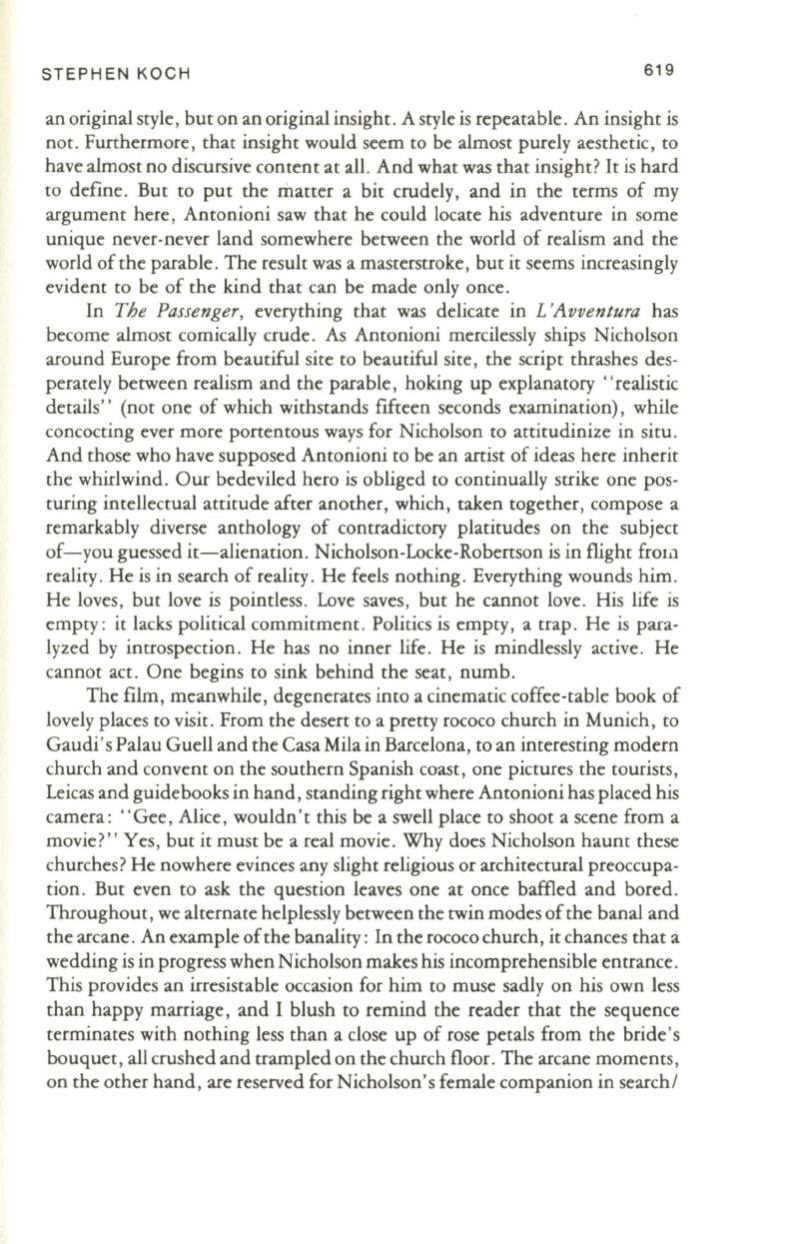
STEPHEN KOCH
619
an original style, but on an original insight. A style is repeatable. An insight is
not. Furthermore , that insight would seem to be almost purely aesthetic , to
have almost no discursive content at all. And what was that insight?
It
is hard
to define . But to put the matter a bit crudely, and in the terms of my
argument here , Antonioni saw that he could locate his adventure in some
unique never-never land somewhere between the world of realism and the
world of the parable . The result was a masterstroke, but it seems increasingly
evident to be of the kind that can be made only once.
In
The Passenger,
everything that was delicate in
L 'Avventura
has
become almost comically crude. As Antonioni mercilessly ships Nicholson
around Europe from beautiful site to beautiful site, the script thrashes des–
perately between realism and the parable, hoking up explanatory " realistic
details" (not one of which withstands fifteen seconds examination), while
concocting ever more portentous ways for Nicholson to attitudinize in situ .
And those who have supposed Antonioni to be an artist of ideas here inherit
the whirlwind . Our bedeviled hero is obliged to continually strike one pos–
turing intellectual attitude after another, which, taken together, compose a
remarkably diverse anthology of contradictory platitudes on the subject
of-you guessed it-alienation . Nicholson-Locke-Robertson is in flight frow
reality . He is in search of reality. He feels nothing. Everything wounds him.
He loves, but love is pointless. Love saves, but he cannot love . His life is
empty : it lacks political commitment. Politics is empty , a trap. He is para–
lyzed by introspection . He has no inner life. He is mindlessly active . He
cannot act. One begins to sink behind the seat, numb .
The film, meanwhile , degenerates into a cinematic coffee-table book of
lovely places to visit. From the desert to a pretty rococo chutch in Munich, to
Gaudi's Palau Guell and the Casa Mila in Barcelona, to an interesting modern
church and convent on the southern Spanish coast, one pictures the tourists,
Leicas and guidebooks in hand, standing right where Antonioni has placed his
camera : •. Gee, Alice, wouldn't this be a swell place to shoot a scene from a
movie?" Yes, but it must be a real movie. Why does Nicholson haunt these
churches? He nowhere evinces any slight religious or architectural preoccupa–
tion . But even to ask the question leaves one at once baffled and bored.
Throughout , we alternate helplessly between the twin modes of the banal and
the arcane. An exampIe of the banality : In the rococo church, it chances that a
wedding is in progress when Nicholson makes his incomprehensible entrance .
This provides an irresistable occasion for him to muse sadly on his own less
than happy marriage, and I blush
to
remind the reader that the sequence
terminates with nothing less than a close up of rose petals from the bride's
bouquet, all crushed and trampled on the church floor. The arcane moments,
on the other hand, are reserved for Nicholson's female companion in search/


